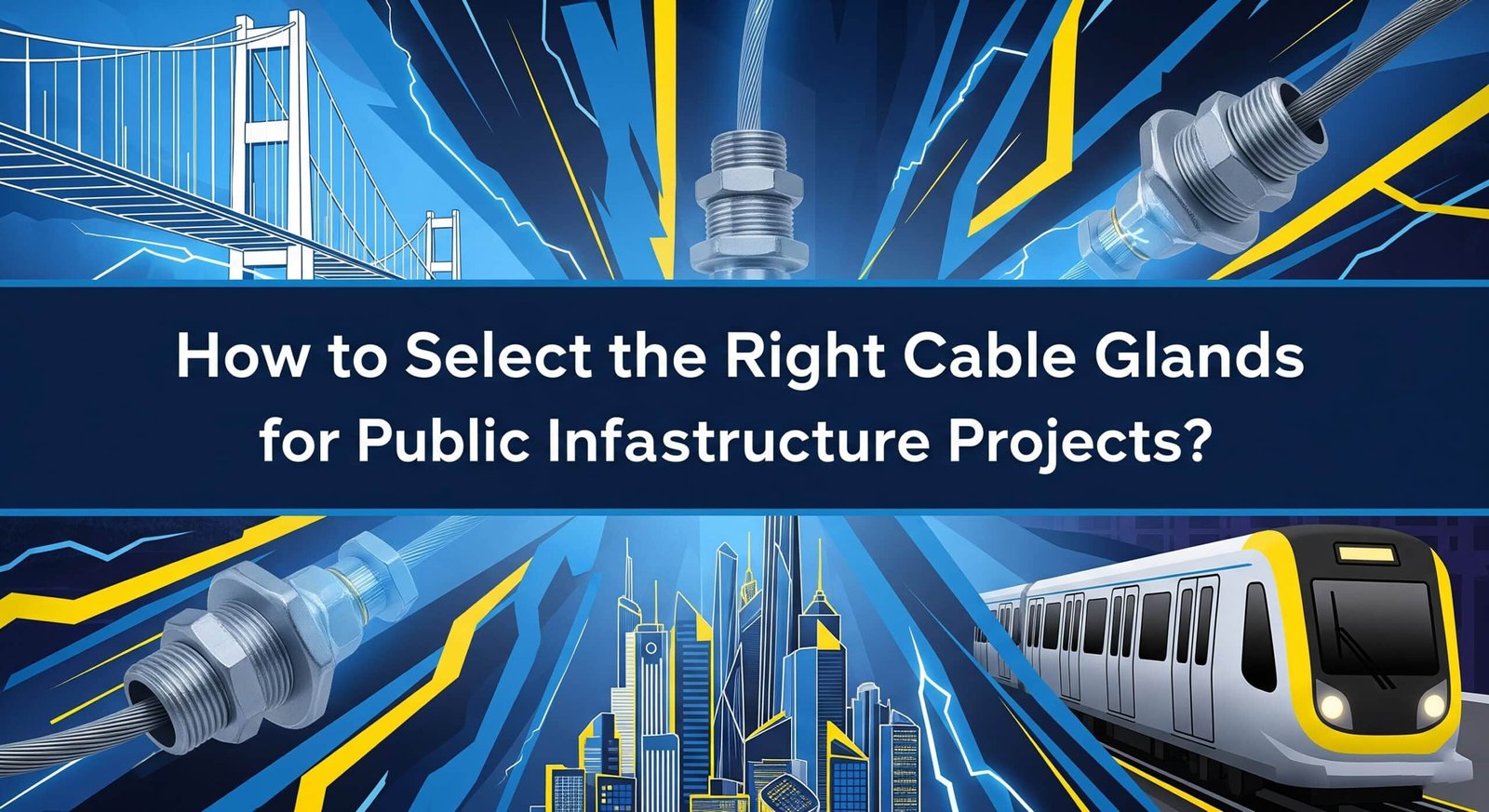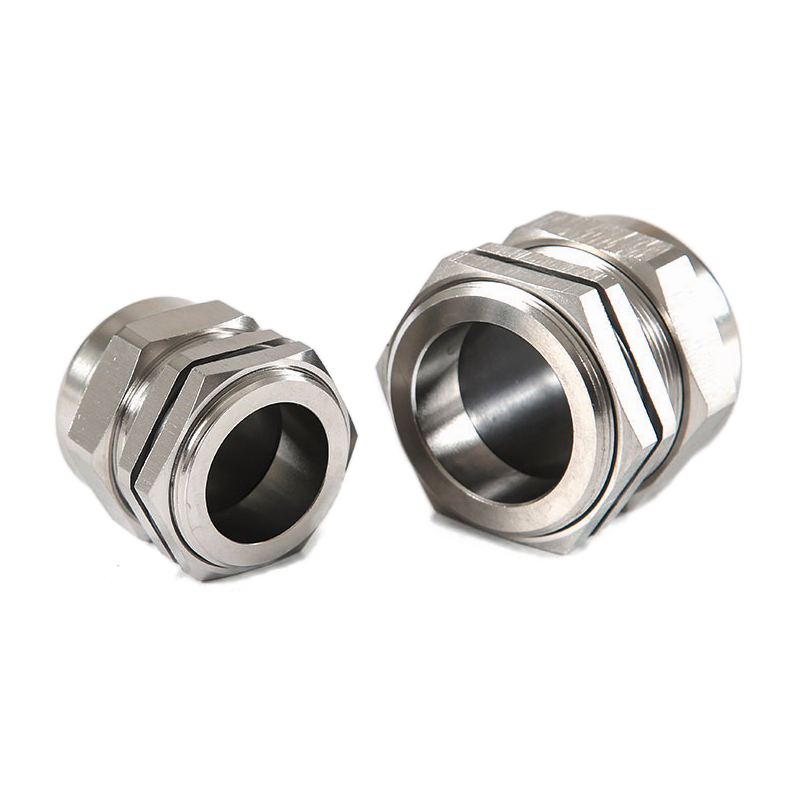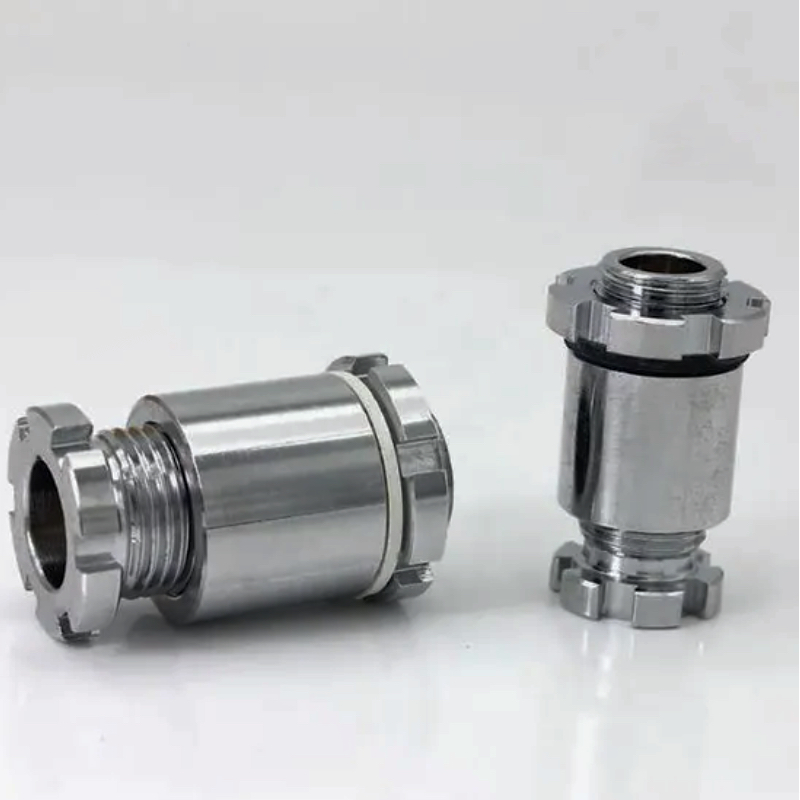Poor cable gland selection in public infrastructure leads to catastrophic system failures, safety hazards, massive repair costs, and potential loss of life when critical lighting, ventilation, or monitoring systems fail in tunnels and bridges, making proper selection absolutely essential for public safety, regulatory compliance, and long-term operational reliability in these demanding environments.
Cable gland selection for public infrastructure requires fire-resistant materials, IP67/IP68 environmental protection, vibration resistance, corrosion protection, and compliance with stringent safety standards including EN 455451 for railways and NFPA codes2 for tunnels, with stainless steel and specialized polymer glands providing optimal performance for lighting systems, ventilation controls, monitoring equipment, and emergency systems in tunnels and bridges.
Having specified cable glands for major infrastructure projects from the Channel Tunnel to the Golden Gate Bridge monitoring systems, I’ve learned that infrastructure applications demand the highest levels of reliability and safety. Let me share the critical selection criteria that ensure your cable glands perform flawlessly for decades in these challenging public environments.
Table of Contents
- What Makes Public Infrastructure Cable Gland Requirements Unique?
- Which Environmental Factors Must You Consider?
- What Safety Standards and Certifications Are Required?
- How Do You Select Glands for Different Infrastructure Systems?
- What Are the Best Practices for Installation and Maintenance?
- FAQs About Infrastructure Cable Glands
What Makes Public Infrastructure Cable Gland Requirements Unique?
Public infrastructure cable gland requirements are unique due to extreme longevity expectations (50+ years), stringent safety regulations, exposure to harsh environmental conditions, limited maintenance access, fire safety requirements, seismic resistance3 needs, and the critical nature of systems where failure could endanger public safety, requiring specialized materials, enhanced certifications, and proven long-term reliability that far exceeds standard industrial applications.
Understanding these unique requirements is essential for proper specification and long-term success.
Extended Service Life Requirements
50+ Year Design Life: Infrastructure projects require cable glands that maintain performance for decades without replacement, far exceeding typical industrial applications.
Material Durability: Premium materials including marine-grade stainless steel, UV-stabilized polymers, and corrosion-resistant alloys ensure long-term performance.
Aging Resistance: Materials must resist degradation from UV exposure, temperature cycling, chemical exposure, and mechanical stress over extended periods.
Maintenance Accessibility: Limited access for maintenance in tunnels and on bridges requires exceptional reliability and minimal maintenance needs.
Public Safety Criticality
Life Safety Systems: Cable glands support critical systems including emergency lighting, ventilation controls, fire detection, and communication systems.
Failure Consequences: System failures can result in public safety hazards, evacuation requirements, and potential loss of life.
Redundancy Requirements: Multiple independent systems require reliable cable glands to maintain system integrity and prevent cascading failures.
Emergency Response: Glands must maintain performance during emergencies including fires, earthquakes, and extreme weather events.
Regulatory Compliance Complexity
Multiple Jurisdictions: Projects often span multiple regulatory jurisdictions with different requirements and approval processes.
International Standards: Compliance with various international standards including IEC, EN, NFPA, and local building codes.
Approval Processes: Lengthy approval processes require extensive documentation and third-party testing verification.
Ongoing Compliance: Continuing compliance requirements throughout the project lifecycle including periodic inspections and certifications.
Environmental Exposure Severity
Weather Extremes: Direct exposure to extreme temperatures, UV radiation, precipitation, and wind loading.
Chemical Exposure: Contact with de-icing chemicals, cleaning agents, exhaust gases, and industrial pollutants.
Mechanical Stress: Vibration from traffic, wind loading, seismic activity, and thermal expansion/contraction.
Moisture Management: Continuous exposure to humidity, condensation, and potential water immersion.
System Integration Complexity
Multiple Cable Types: Integration with power cables, control cables, fiber optics, and communication systems.
Electromagnetic Compatibility: EMC requirements for sensitive monitoring and communication equipment.
Grounding Systems: Integration with comprehensive grounding and bonding systems for electrical safety.
Future Expansion: Accommodation of future system upgrades and technology changes.
Cost and Procurement Considerations
| Factor | Infrastructure Requirements | Standard Industrial | Impact on Selection |
|---|---|---|---|
| Initial Cost | Higher acceptable cost | Cost optimization focus | Premium materials justified |
| Lifecycle Cost | Minimize total cost | Balance initial/operating | Long-term reliability priority |
| Procurement Process | Formal bidding/approval | Direct purchase | Extensive documentation required |
| Warranty Requirements | Extended warranties | Standard terms | Proven track record essential |
| Supplier Qualification | Rigorous qualification | Basic approval | Established infrastructure suppliers |
David, a project manager for the new Hudson River tunnel project in New York, faced challenges specifying cable glands for the tunnel’s critical ventilation system. The 50-year design life requirement, combined with salt air exposure and fire safety regulations, demanded specialized stainless steel cable glands with NFPA compliance. We provided marine-grade 316L stainless steel glands with full fire testing certification that met all project requirements and have performed flawlessly through two years of harsh winter conditions. 😊
Which Environmental Factors Must You Consider?
Environmental factors for infrastructure cable glands include extreme temperature ranges (-40°C to +85°C), UV radiation exposure, chemical attack from de-icing salts and pollutants, mechanical vibration from traffic and wind, moisture ingress from rain and condensation, seismic forces, and electromagnetic interference, all requiring careful material selection, enhanced sealing systems, and specialized protective coatings to ensure reliable long-term performance.
Comprehensive environmental analysis is critical for proper cable gland specification and system reliability.
Temperature Extremes and Cycling
Wide Temperature Ranges: Infrastructure installations experience temperature ranges from -40°C in arctic conditions to +85°C in direct sunlight.
Thermal Cycling: Daily and seasonal temperature variations create expansion/contraction stress that can compromise sealing integrity.
Solar Loading: Direct sunlight exposure creates localized heating that can exceed ambient temperatures by 20-30°C.
Thermal Mass Effects: Large concrete and steel structures create thermal lag effects that influence local temperature conditions.
UV Radiation and Weather Exposure
UV Degradation: Continuous UV exposure degrades polymer materials, requiring UV-stabilized compounds and protective coatings.
Weather Resistance: Direct exposure to rain, snow, ice, and wind requires enhanced environmental sealing and mechanical strength.
Freeze-Thaw Cycling: Repeated freeze-thaw cycles can damage inadequately protected cable glands and sealing systems.
Storm Conditions: Extreme weather events create temporary but severe loading conditions that glands must survive.
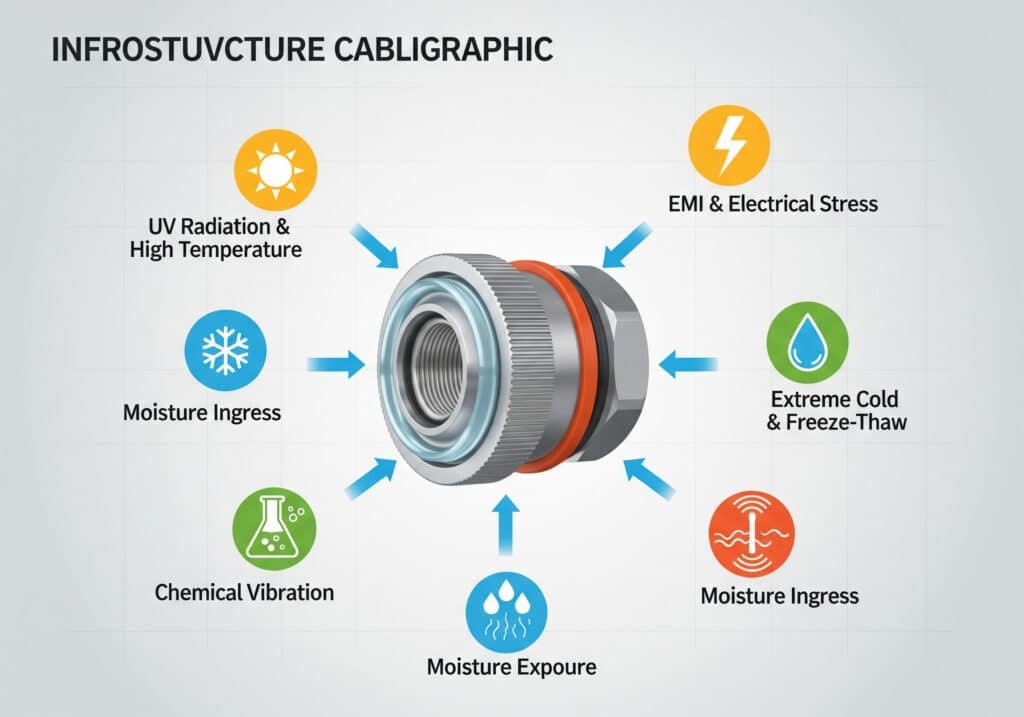
Chemical Exposure Challenges
De-icing Chemicals: Road salt, calcium chloride, and other de-icing agents create highly corrosive conditions.
Air Pollution: Urban environments expose glands to acid rain, ozone, and various industrial pollutants.
Cleaning Chemicals: Maintenance activities involve pressure washing and chemical cleaning that can affect gland materials.
Fuel and Oil Exposure: Vehicle emissions and occasional spills create hydrocarbon exposure conditions.
Mechanical Stress Factors
Traffic Vibration: Continuous vibration from vehicle traffic creates fatigue stress in cable gland connections.
Wind Loading: Bridge installations experience significant wind loading that creates mechanical stress.
Seismic Activity: Earthquake zones require glands that can withstand seismic forces without failure.
Structural Movement: Thermal expansion and live loading cause structural movement that stresses cable connections.
Moisture and Humidity Management
High Humidity: Tunnel environments often maintain high humidity levels that challenge sealing systems.
Condensation: Temperature differentials create condensation that can compromise electrical systems.
Water Immersion: Flood conditions may temporarily immerse cable glands, requiring IP68 protection.
Drainage Requirements: Proper drainage design prevents water accumulation around cable gland installations.
Electromagnetic Environment
EMI Sources: Power systems, radio transmitters, and electronic equipment create electromagnetic interference.
Grounding Requirements: Proper grounding and shielding prevent EMI-related system failures.
Lightning Protection: Lightning strike protection requires specialized grounding and surge protection systems.
Communication Systems: Sensitive communication equipment requires EMC-compliant cable glands.
Site-Specific Considerations
Marine Environments: Coastal locations require enhanced corrosion protection and salt spray resistance.
Industrial Areas: Chemical plants and refineries create specialized chemical exposure conditions.
Urban Heat Islands: City environments create elevated temperatures and air pollution exposure.
Remote Locations: Limited maintenance access requires exceptional reliability and self-monitoring capabilities.
Environmental Testing Requirements
Accelerated Aging: UV chambers and thermal cycling tests simulate long-term environmental exposure.
Salt Spray Testing4: ASTM B117 testing verifies corrosion resistance for marine and de-icing salt exposure.
Chemical Resistance: Immersion testing in relevant chemicals verifies long-term compatibility.
Vibration Testing: Mechanical testing simulates traffic and wind-induced vibration effects.
What Safety Standards and Certifications Are Required?
Safety standards for infrastructure cable glands include fire safety certifications like EN 45545 for rail tunnels, NFPA 130 for transit systems, UL 2196 for building applications, seismic certifications for earthquake zones, environmental protection standards (IP67/IP68), EMC compliance for electronic systems, and regional building codes, with third-party testing and ongoing surveillance required to maintain certifications throughout the project lifecycle.
Understanding and meeting these standards is mandatory for project approval and public safety.
Fire Safety Standards
EN 45545 Railway Applications: European standard for fire protection in railway vehicles and infrastructure, covering toxicity, smoke production, and flame spread.
NFPA 130 Transit Systems: US standard for fixed guideway transit and passenger rail systems, including tunnel ventilation and emergency systems.
UL 2196 Building Applications: Standard for tests of fire resistive cables used in buildings and other structures.
Local Fire Codes: Municipal and regional fire codes that may impose additional requirements beyond national standards.
Seismic and Structural Standards
IBC Seismic Requirements: International Building Code requirements for seismic design and installation methods.
ASCE 7 Structural Loading: American Society of Civil Engineers standard for minimum design loads and associated criteria.
Eurocode 8 Seismic Design: European standard for earthquake-resistant design of structures and infrastructure.
Regional Seismic Codes: Local seismic codes that may exceed national standards in high-risk areas.
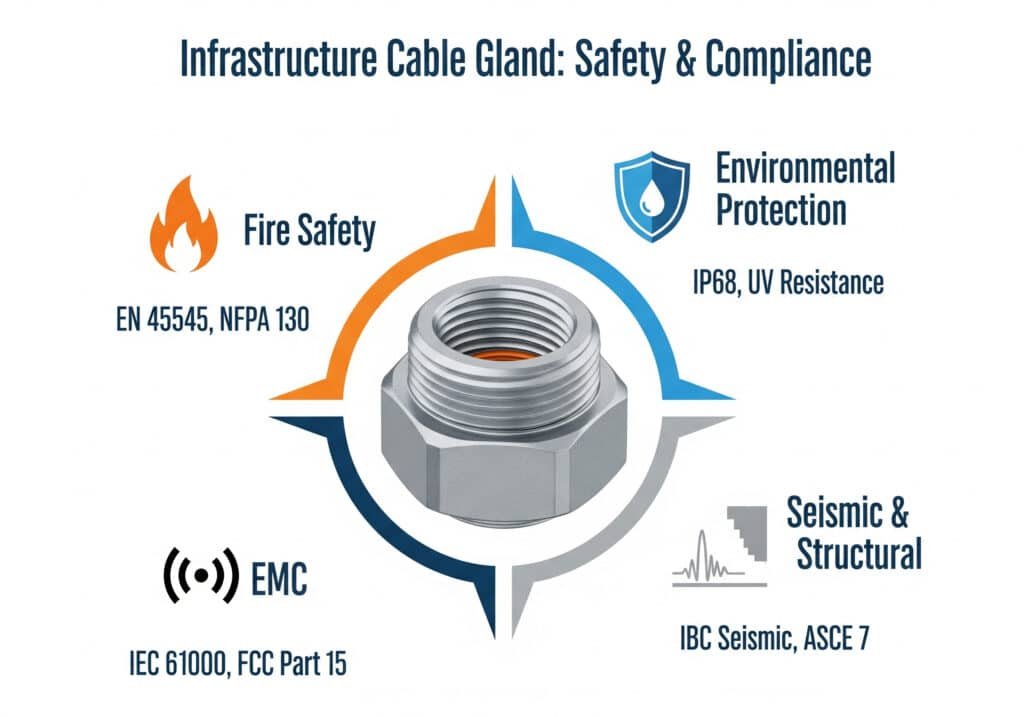
Environmental Protection Standards
IP Rating Requirements: IP67 minimum for outdoor applications, IP68 for potential immersion conditions.
NEMA Enclosure Ratings: US standard for environmental protection of electrical equipment enclosures.
Corrosion Resistance: ASTM standards for salt spray testing and corrosion resistance verification.
UV Resistance: ASTM G154 and similar standards for UV exposure testing and material qualification.
Electromagnetic Compatibility
EMC Directive 2014/30/EU: European electromagnetic compatibility requirements for electrical equipment.
FCC Part 15: US Federal Communications Commission requirements for electromagnetic interference.
IEC 61000 Series: International standards for electromagnetic compatibility testing and requirements.
MIL-STD-461: Military standard for electromagnetic interference and compatibility requirements.
Material and Construction Standards
ROHS Compliance: Restriction of hazardous substances in electrical and electronic equipment.
REACH Regulation: European regulation on chemical substances and their safe use.
UL Recognition: Underwriters Laboratories component recognition for use in listed products.
CSA Certification: Canadian Standards Association certification for Canadian market access.
Quality Management Standards
ISO 9001 Quality Management5: International standard for quality management systems and processes.
ISO 14001 Environmental Management: Standard for environmental management systems and sustainability.
IATF 16949 Automotive Quality: Automotive industry quality management standard for critical applications.
AS9100 Aerospace Quality: Aerospace industry quality management standard for high-reliability applications.
Testing and Verification Requirements
Third-Party Testing: Independent testing laboratories verify compliance with applicable standards.
Factory Inspections: Regular factory audits ensure ongoing compliance with quality and safety standards.
Product Surveillance: Ongoing product testing and surveillance maintain certification validity.
Documentation Requirements: Comprehensive documentation packages support regulatory approval processes.
Regional and Local Requirements
European CE Marking: Conformity marking indicating compliance with applicable EU directives.
US Building Codes: State and local building codes that may impose additional requirements.
Canadian Standards: CSA standards and provincial requirements for Canadian installations.
International Projects: Country-specific standards and approval processes for international projects.
How Do You Select Glands for Different Infrastructure Systems?
Selecting cable glands for different infrastructure systems requires matching specific performance requirements to system criticality, with emergency lighting requiring fire-resistant materials and battery backup compatibility, ventilation systems needing vibration resistance and EMC protection, monitoring equipment demanding precision sealing and electromagnetic shielding, and power distribution systems requiring high current capacity and fault protection, each with specialized material and certification requirements.
System-specific selection ensures optimal performance and regulatory compliance.
Emergency Lighting Systems
Fire Resistance Requirements: Cable glands must maintain circuit integrity during fires to ensure emergency lighting remains operational.
Battery System Compatibility: Compatibility with emergency battery systems and automatic transfer equipment.
Photoluminescent Integration: Integration with photoluminescent marking systems for enhanced visibility.
Maintenance Accessibility: Easy access for routine testing and lamp replacement in emergency lighting systems.
Tunnel Ventilation Systems
High-Power Applications: Ventilation fans require cable glands rated for high current and voltage applications.
Vibration Resistance: Continuous operation of large fans creates significant vibration that glands must withstand.
Environmental Sealing: Exposure to vehicle exhaust and cleaning chemicals requires enhanced chemical resistance.
Emergency Operation: Systems must maintain operation during emergency conditions including fires and accidents.
Monitoring and Control Systems
EMC Protection: Sensitive electronic equipment requires EMC cable glands to prevent interference.
Precision Sealing: Environmental protection for sensitive sensors and monitoring equipment.
Communication Integration: Compatibility with fiber optic and communication cable requirements.
Data Integrity: Protection of data transmission cables from electromagnetic interference and environmental factors.
Traffic Management Systems
Signal Timing Systems: Precise timing requirements for traffic signals and coordination systems.
Variable Message Signs: High-brightness LED displays require specialized power and control cable protection.
Sensor Networks: Traffic detection sensors require reliable environmental protection and EMC compliance.
Communication Networks: Integration with traffic management communication systems and emergency services.
Bridge Monitoring Systems
Structural Health Monitoring: Sensors that monitor bridge structural integrity require precision cable protection.
Weather Monitoring: Environmental sensors exposed to extreme weather conditions.
Load Monitoring: Weight and stress sensors that monitor bridge loading and safety.
Seismic Monitoring: Earthquake detection and monitoring systems in seismic zones.
Power Distribution Systems
High Voltage Applications: Specialized glands for medium and high voltage power distribution cables.
Fault Protection: Integration with ground fault and arc fault protection systems.
Load Management: Smart grid integration and load management system compatibility.
Renewable Integration: Solar and wind power integration systems for sustainable infrastructure.
Selection Matrix by System Type
| System Type | Primary Requirements | Recommended Gland Type | Key Certifications | Environmental Rating |
|---|---|---|---|---|
| Emergency Lighting | Fire resistance, reliability | Fire-rated polymer/metal | EN 45545, UL 2196 | IP65 minimum |
| Ventilation Control | Vibration resistance, EMC | Stainless steel with EMC | NFPA 130, EMC directive | IP67 |
| Monitoring Systems | EMC protection, precision | EMC cable glands | IEC 61000, FCC Part 15 | IP67/IP68 |
| Traffic Signals | Weather resistance, reliability | UV-stable polymer | NEMA standards | IP65 |
| Bridge Monitoring | Seismic resistance, longevity | Marine-grade stainless | Seismic codes, ASTM | IP68 |
| Power Distribution | High current, fault protection | Heavy-duty metal | UL listing, CSA | IP66 |
Integration Considerations
System Interdependence: Understanding how different systems interact and affect each other’s cable gland requirements.
Future Expansion: Designing cable gland installations to accommodate future system upgrades and additions.
Maintenance Coordination: Coordinating maintenance schedules across different systems to minimize disruption.
Emergency Procedures: Ensuring cable gland selections support emergency response and evacuation procedures.
Hassan, who oversees infrastructure maintenance for the Dubai Metro system, needed cable glands for a major tunnel ventilation upgrade. The system required EMC protection for sensitive control equipment, fire resistance for emergency operation, and corrosion resistance for the harsh desert environment. We provided specialized stainless steel EMC cable glands with EN 45545 fire certification that have maintained perfect performance through three years of continuous operation in temperatures exceeding 50°C.
What Are the Best Practices for Installation and Maintenance?
Best practices for infrastructure cable gland installation include comprehensive pre-installation planning with detailed drawings and specifications, qualified installer training and certification, systematic quality control with inspection checkpoints, proper documentation and record keeping, preventive maintenance scheduling based on system criticality, and emergency response procedures, all supported by manufacturer technical support and ongoing performance monitoring to ensure long-term reliability.
Following established best practices ensures optimal performance and minimizes lifecycle costs.
Pre-Installation Planning
Detailed Engineering: Complete engineering drawings and specifications that address all installation requirements and constraints.
Site Surveys: Thorough site surveys to identify potential installation challenges and environmental conditions.
Material Coordination: Coordination of cable gland delivery with other project materials and construction schedules.
Access Planning: Planning for equipment access, staging areas, and safety requirements during installation.
Installer Qualification and Training
Certified Installers: Use only qualified and certified installers with infrastructure project experience.
Manufacturer Training: Specialized training on specific cable gland products and installation techniques.
Safety Training: Comprehensive safety training for working in tunnels, on bridges, and around traffic.
Quality Standards: Training on quality standards and inspection requirements for infrastructure applications.
Installation Quality Control
Inspection Checklists: Systematic inspection checklists that verify all installation requirements are met.
Torque Verification: Proper torque application using calibrated tools and documented procedures.
Environmental Testing: Post-installation testing to verify environmental protection and system performance.
Documentation Requirements: Complete documentation of installation parameters and any deviations from specifications.
Preventive Maintenance Programs
Risk-Based Scheduling: Maintenance schedules based on system criticality and environmental exposure conditions.
Condition Monitoring: Regular condition assessments to identify potential issues before failure occurs.
Performance Trending: Tracking of key performance indicators to optimize maintenance intervals.
Spare Parts Management: Strategic spare parts inventory management for critical infrastructure systems.
Documentation and Record Keeping
Installation Records: Comprehensive records of all installation activities, materials used, and test results.
Maintenance Logs: Detailed maintenance logs including inspection results, repairs, and replacements.
Performance History: Long-term performance tracking to support lifecycle management decisions.
Regulatory Compliance: Documentation to support ongoing regulatory compliance and audit requirements.
Emergency Response Procedures
Failure Response: Rapid response procedures for cable gland failures that could affect public safety.
Backup Systems: Coordination with backup systems and redundant installations during maintenance.
Emergency Contacts: 24/7 emergency contact procedures for critical system failures.
Restoration Procedures: Systematic procedures for rapid system restoration after emergencies.
Lifecycle Management
Performance Monitoring: Ongoing monitoring of cable gland performance and environmental conditions.
Upgrade Planning: Planning for system upgrades and technology improvements over the infrastructure lifecycle.
End-of-Life Management: Procedures for cable gland replacement and disposal at end of service life.
Continuous Improvement: Incorporation of lessons learned and new technologies into maintenance practices.
Vendor Support and Partnerships
Technical Support: Ongoing technical support from cable gland manufacturers and suppliers.
Training Updates: Regular training updates on new products and installation techniques.
Performance Reviews: Periodic performance reviews with suppliers to optimize product selection and support.
Innovation Partnerships: Collaboration with suppliers on new technologies and improved solutions.
Conclusion
Selecting the right cable glands for public infrastructure requires understanding unique environmental challenges, safety requirements, and long-term performance expectations. Success depends on matching specific system requirements with appropriate cable gland technologies and certifications.
The key to successful infrastructure cable gland selection lies in comprehensive planning, proper specification, quality installation, and proactive maintenance. At Bepto, we provide specialized infrastructure-grade cable glands and comprehensive technical support to help ensure your critical infrastructure systems operate safely and reliably for decades to come.
FAQs About Infrastructure Cable Glands
Q: What’s the difference between infrastructure and industrial cable glands?
A: Infrastructure cable glands require 50+ year service life, enhanced fire safety certifications, and stricter environmental protection compared to standard industrial glands. They must meet specialized standards like EN 45545 for rail applications and withstand more severe environmental conditions.
Q: Do I need special certifications for tunnel cable glands?
A: Yes, tunnel applications typically require fire safety certifications like NFPA 130 or EN 45545, plus enhanced environmental protection (IP67/IP68) and often EMC compliance for control systems. Specific requirements vary by jurisdiction and tunnel type.
Q: How long should infrastructure cable glands last?
A: Infrastructure cable glands should provide 50+ years of reliable service with minimal maintenance. This requires premium materials like marine-grade stainless steel and UV-stabilized polymers designed for long-term environmental exposure.
Q: What IP rating do I need for bridge cable glands?
A: Bridge applications typically require IP67 minimum for weather exposure, with IP68 recommended for areas subject to flooding or pressure washing. The rating depends on specific installation location and environmental conditions.
Q: Can I use standard cable glands in infrastructure projects?
A: Standard cable glands rarely meet infrastructure requirements for service life, environmental protection, and safety certifications. Infrastructure projects require specialized glands designed for these demanding applications with appropriate certifications and proven track records.
-
Learn about the EN 45545 standard, which specifies fire protection requirements for materials and components on railway vehicles and infrastructure. ↩
-
Explore the codes and standards developed by the National Fire Protection Association (NFPA) to minimize the risk of fire. ↩
-
Understand the principles of seismic design for nonstructural components, which ensure equipment remains functional during and after an earthquake. ↩
-
Review the ASTM B117 standard, the benchmark practice for operating salt spray (fog) apparatus to assess corrosion resistance. ↩
-
Discover the requirements of the ISO 9001 standard, the international benchmark for a company’s quality management system. ↩

